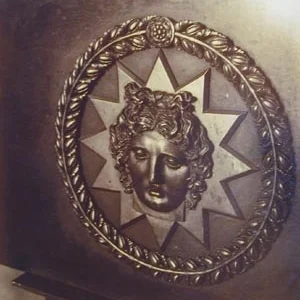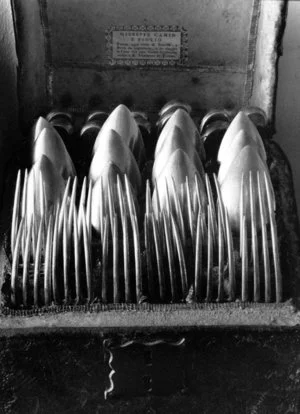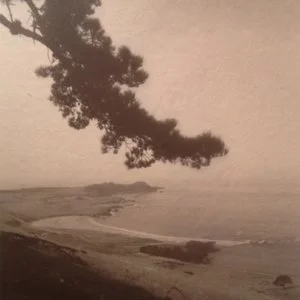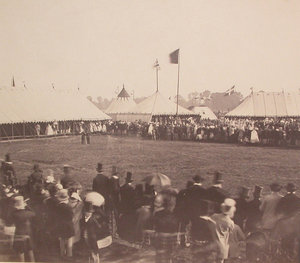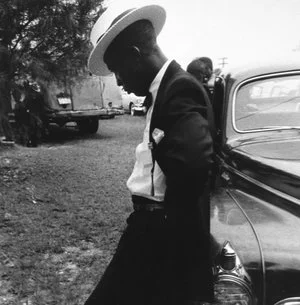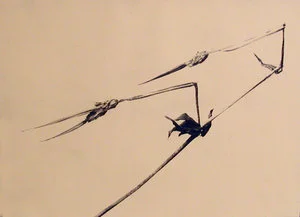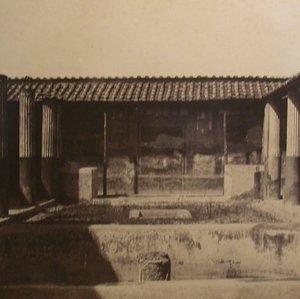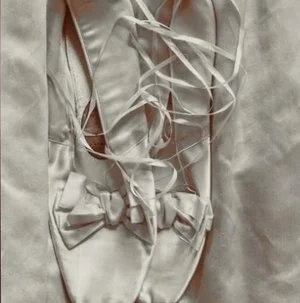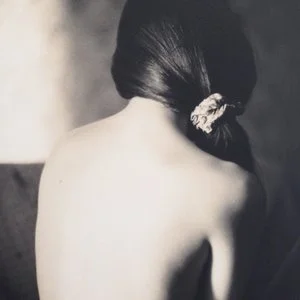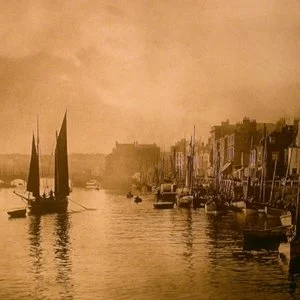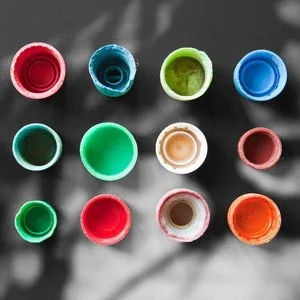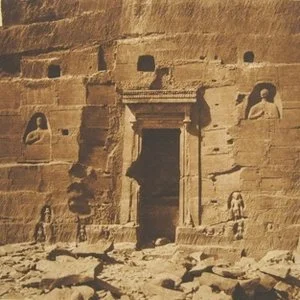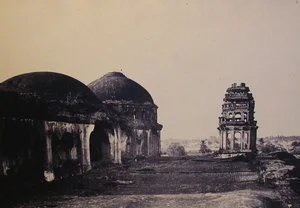Berenice Abbott left the American Midwest in 1918 to study in New York City, Paris, and Berlin. In Paris she became an assistant to Man Ray and Eugène Atget. In 1925 she set up her own studio and made portraits of Parisian artists, writers, collectors and expatriates. She retrieved and catalogued Atget's prints and negatives after his death. In the 1930s she photographed New York's neighborhoods for the WPA Federal Art Project, documenting its changing architecture; many of the photographs were published in Changing New York (1939).
Read MoreAnsel Easton Adams was known for his black and white photographs of the California's Yosemite Valley. Adams was also the author of numerous books about photography, including his trilogy of technical instruction manuals (The Camera, The Negative, and The Print). He co-founded the photographic association Group f/64 along with other masters like Edward Weston, Willard Van Dyke, Imogen Cunningham and others. He invented the zone system, a technique which allows photographers to translate the light they see into specific densities on negatives and paper, thus giving them better control over finished photographs. Adams also pioneered the idea of visualization (which he often called 'previsualization', though he later acknowledged that term to be a redundancy) of the finished print based upon the measured light values in the scene being photographed.
Read MoreThe work of Eugène Atget is one of the richest pictorial embodiments of French culture. Working as a photographer mainly in and near Paris from the late 1890s until his death in 1927, Atget made a total of about 10,000 individual images. Over the course of his long career he discovered and progressively mastered photography’s capacity to transform plain fact into visual poetry. In the rapid unfolding of modernist photography in the late 1920s and early 1930s, Atget’s work soon became the exemplar of the medium’s new creative power. No major photographer in the half-century following his death was untouched by Atget’s influence. At his death in 1927, the French government purchased a portion of Atget’s negatives; the remaining contents of his studio and greater body of his work were purchased by photographer Berenice Abbott and art dealer Julian Levy. Carefully looked after by Abbott, the collection was later sold to the Museum of Modern Art.
Read MoreKnown for American fashion and portrait photography. An obituary published in The New York Times said that "his fashion and portrait photographs helped define America's image of style, beauty and culture for the last half-century".
Read MoreAfter briefly considering a career in journalism, Morley Baer began his artistic career as a landscape and architectural photographer. Having seen an Edward Weston exhibition in Chicago, Baer’s mind was made up; he was California-bound to pursue photography and to meet Weston himself. Following naval service during WWII, Baer returned to Carmel once again, where Weston was still living. A close friendship was formed between the two photographers over these years. Baer’s work elicits a kind of intimate pleasure, evoking in many a sense of familiarity with what may often be an unknown land. Morley Baer represents a generation of photographers whose aesthetic interest in the landscape was inseparable from their love of the land itself.
Read MoreJohn Anthony Baldessari is an American conceptual artist known for his work featuring found photography and appropriated images. He lives and works in Santa Monica, California. Initially a painter, Baldessari began to incorporate texts and photography into his canvases in the mid-1960s. In 1970 he began working in printmaking, film, video, installation, sculpture and photography. He has created thousands of works that demonstrate - and, in many cases, combine - the narrative potential of images and the associative power of language within the boundaries of the work of art. His art has been featured in more than 200 solo exhibitions in the U.S. and Europe.
Read MoreÉdouard Baldus was born in 1820 in France and worked as a painter in the 1840s photography peeked his interest. He was a founding member of the Societe Heliographique and an important influence to the art of heliogravure, a photomechanical process. He used the calotype process from 1851 and began using collodion wet-plate negatives and albumen prints in 1956. A pioneer of the photographic medium, he documented architectureal monuments of France as well as landscpes, paintings and the documentation of the Rhone Floods. In 1851 he was commissioned by the Comite des Monuments Historiques to photograph monuments in Paris, Fontainebleau, Burgundy, the Dauphine, Normandy, Auvergne and Provence. During 1854-1855 Baldus created 1,500 photographs of a new wing of the Louvre in Paris and was commissioned by Baron James de Rothschild to photograph the railroad lines in France.
Read MoreIn his photography, Jeffrey Becom combines an architect’s love of geometry, pattern and texture with a painter’s sensitivity to color, light, and composition. He spent a decade creating his series of photographs on the Mediterranean, collected in the book Mediterranean Color with Pulitzer Prize-winning critic Paul Goldberger. Becom then began photographing throughout Mexico and Central America, documenting the traditions of the living Maya in his book Maya Color. Having recently voyaged to India, Becom’s latest work depicts the beauty and power of the colorful traditions of Indian architecture. His extraordinarily vivid images are also a testimony to his eye for form and composition. His photographs are represented in public and private collections throughout the world.
Read MoreIn a career spanning more than seven decades, Ruth Bernhard has created an imposing body of work. Distinguished by their exquisite use of light, her images have been internationally recognized and acclaimed by her peers. Radiant still-life studies and nude forms reflect her passionate search for the universal connection of all things. Said by Ansel Adams to be the finest photographer of the nude, Bernhard is associated with the history of Northern California's wealth of eminent photographers, among them Adams, Edward Weston, Imogen Cunningham, and Dorothea Lange. Bernhard's work has been exhibited and included in the permanent collections of major museums and universities in the United States, Europe, Japan, and Mexico, and has been published worldwide.
Read MoreBoubat was born in Montmartre, Paris. He studied typography and graphic arts at the École Estienne and worked for a printing company before becoming a photographer. In 1943 he was subjected to service du travail obligatoire, forced labour of French people in Nazi Germany, and witnessed the horrors of World War II. He took his first photograph after the war in 1946 and was awarded the Kodak Prize the following year. He travelled the world for the French magazine Réalités, where his colleague was Jean-Philippe Charbonnier, and later worked as a freelance photographer. French poet Jacques Prévert called him a "peace correspondent" as he was humanist, apolitical and photographed uplifting subjects. His son Bernard Boubat is also a photographer.
Read MoreHaving apprenticed to Man Ray, Brandt originally began his career working as a photojournalist on assignment. His photography was a singular and idiosyncratic mixture of straight reportage with a consistent, if subtle, streak of strangeness - the legacy of surrealism. He would eventually turn from “straight” photography, so dominant in the post-war culture of the time, towards abstracted images in which figures were distorted or wide-angle lenses used. Highly respected for the intensity and power of his images, Brandt is considered one of the preeminent photographers to have emerged in England.
Read MoreManuel Alvarez Bravo was one of the founders of modern photography and considered the main representative of Latin American photography in the 20th century. His work extends from the late 1920s to the 1990s. Álvarez Bravo was born in downtown Mexico City on February 4, 1902. He left school at the age of twelve in order to begin making a contribution to his family’s finances after his father's death. He worked at a textile factory for a time, and later at the National General Treasury.
Read MoreWynn Bullock began his photographic career at the age of 42 studying at the Art Center School in Los Angeles, California. A lifelong friend of Edward Weston, his work and influence thrived in Bullock's photographs and in 1968, he became a trustee and chairman of the exhibition committee during the formative years of Friends of Photography in Carmel, California. Bullock is recognized as an American master photographer of the 20th Century. His work is included in over 90 major museum collections around the world including The Museum of Modern Art, The San Francisco Museum of Modern Art, The Hallmark Collection of Photography and The Center for Creative Photography which holds the archives of Ansel Adams, Harry Callahan, Frederick Sommer and Aaron Siskind.
Read MoreSince 1985 Linda Butler has worked as an independent art-photographer and is known for her explorations of other cultures. Her most recent book, Yangtze Remembered: The River Beneath the Lake, is an historical document of the Three Gorges Dam project in China. During a three-year period (from 2000 – 2003) Butler made eight trips to China. She captured the complexity of the Three Gorges Project and the beauty of the Yangtze before life was changed forever by the dam. Through her photographs we see common people, architectural interiors and dramatic landscapes. We watch the destruction of the old way of life and the construction of the new in before-and-after photographs of the river and its shores. Published by Stanford University Press (©2004), Yangtze Remembered explores the historical and environmental context of the dam through 109 photographs and 55 pages of text. Butler’s other books include Italy: In the Shadow of Time (Rizzoli International ©1998), Rural Japan: Radiance of the Ordinary (Smithsonian Institution Press ©1992), and Inner Light: The Shaker Legacy (Knopf ©1985).
Read MoreHarry Callahan was an American photographer born in Detroit. Self-taught, he began taking pictures in 1938 as a hobby and, inspired by the work of Ansel Adams, began to produce professional-quality photographs in the 1940s. His mature work is said to mingle the precision of Americans like Adams with the experimentalism of Europeans like Lázló Moholy-Nagy. His black-and-white city streetscapes and rural landscapes combine the commonplace with the starkly abstract, exploring contrasts of sunlight and shadow, tone and texture, static buildings and hurried passersby, while his many lovingly distinctive portraits of his wife and daughter are extremely personal and intimate. He sometimes used multiple exposures, and experimented with color slide film in the 1940s, again making color images from 1977 on. An influential figure in modern photography, he taught at Chicago's Institute of Design (1946-61) and the Rhode Island School of Design (1961-77).
Read MoreSparky Campanella is a Los Angeles based self-taught photographer who switched careers in 2001 from software marketing to fine-art photography. His figurative works are typically conceptual and abstract, with a minimal aesthetic. Sparky grew up in Pittsburgh and has been photographing almost as long as he’s been walking. He has shown his work in group exhibitions nationally including Center for Photography at Woodstock, Woodstock; Umbrella Arts, NYC; The Print Center, Philadelphia; Texas Photographic Arts, San Antonio; SF Camerawork, San Francisco; Gallery 825, Los Angeles; and Irvine Fine Arts Center, Irvine. He holds an undergraduate degree from Duke University and a graduate degree from Stanford University. He has been an instructor at the Harvey Milk Institute in San Francisco and at Prescott College in Arizona. He has been awarded residencies at the School of Visual Arts in New York City and Anderson Ranch in Colorado.
Read MorePaul Caponigro is one of America's most significant master photographers. Born in Boston in 1932, he began photographing as a youth at thirteen. He has subsequently sustained an artistic career spanning over forty years, which began in earnest in 1951 and involved studies with Minor White and Benjamen Chinn. Caponigro's first one-man show at the George Eastman house took place in 1958. Since that time he has been widely exhibited throughout the United States and Europe. Two Guggenheim Fellowships and three NEA grants have been awarded to Caponigro over the course of his photographic career in recognition of his singularly masterful and uncompromising artistry. His work forms a visual bridge between the material world of physical forms and the living spirit behind them.
Read MorePatty Carroll has been known for her use of highly intense, saturated color photographs since the 1970’s. Her most recent project, “Anonymous Women,” consists of a 3-part series of studio installations made for the camera, addressing women and their complicated relationships with domesticity. By camouflaging the figure in drapery and/or domestic objects, Carroll creates a dark and humorous game of hide-and-seek between her viewers and the Anonymous Woman. The photographs are published as a monograph, Anonymous Women, officially released in January, 2017 by Daylight Books.
Read MoreHenri Cartier-Bresson was persuaded by Robert Capa to call himself a photojournalist rather than an artist or a Surrealist for his first New York show. Best known for his concept of the "decisive moment" in photography. At its best this leads to a dynamic image but easily becomes - even occasionally in the hands of the master himself - a formal stasis. Cartier-Bresson is the recipient of an extraordinary number of prizes, awards and honorary doctorates including the Overseas Press Club of America Award (1948, 1954, 1960, 1964), The A.S.M.P. Award (1953), the Prix de la Société Française de Photographie (1959), the Culture Prize, Deutsche Gesellschaft für Photographie (1975). Capa also persuaded Cartier-Bresson to become one of the founders of Magnum.
Read MoreMark Citret has always been intrigued by the everyday wonders of the visual world. The sense of expansive awareness that for Citret is a prerequisite to photography enables him to capture the small everyday flashes of insight that come when we are open to them and often go before we can fully grasp or appreciate them. Sights that most of us tend not to notice—a weathered phone book, an empty bulletin board, a twisted chain link fence—seem full of meaning, made spectacular and somehow poignant through his eye. Citret’s images are a sort of meditation in seeing; though they rarely contain human forms, they are powerful testaments to the relationship between human presence and transitory nature. Fascinated from his earliest work with the delicate nuances possible in black and white, his work with vellum paper allows him to convey the ideas of softer ranges in his work. Luminous and warm, the vellums heighten the sense of everyday epiphany found in his images.
Read MoreImogen Cunningham occupies a singular position in the history of American art of the twentieth century. For over half the history of photography, she explored- with innovation and a new perspective- all the major traditions associated with the medium as fine art. She has been most widely acclaimed for the photographs made during the 1920s and 1930s, particularly close-up images of plants and nudes. She also made portraits which are now considered classics in photography, including images of Alfred Stieglitz, Spencer Tracy, and Martha Graham. She was a founding member of the West Coast-based Group f.64, which championed an un-manipulated, direct approach with the camera, or “straight” photography. Her photographs are represented in major collections and museums around the world. The Weston Gallery represents the Imogen Cunningham Trust and have vintage, modern as well as posthumous prints available.
Read MoreGroup f/64 was a group founded by seven 20th-century San Francisco Bay Area photographers who shared a common photographic style characterized by sharply focused and carefully framed images seen through a particularly Western (U.S.) viewpoint. In part, they formed in opposition to the pictorial photographic style that had dominated much of the early 20th century, but moreover, they wanted to promote a new modernist aesthetic that was based on precisely exposed images of natural forms and found objects.
Read MoreRobb Johnson creates haunting and mysterious black and white photographs reminiscent of the chiaroscuro style of the old Italian masters. The unusual atmospheric conditions he finds by photographing in the dark of night imbue his photographs with mystery. He sets a stage where the actors seem to have just stepped off or have yet to arrive for some unknown drama. Johnson’s photographs evoke a world where the viewer is free to explore with his or her own emotions and awareness – a drama unbeknownst but to them. Robb was a scholarship student at Art Center College of Design and earned a BFA in Photography. He worked in advertising photography for over 20 years, specializing in creating visual environments for national hotels with his wife Dale. He decided to turn his visual focus inward and pursue his art for himself. His work has been featured in B&W Magazine, Spotlight and B&W Single Image for 2006, 2007 and 2008 and his book, Robb Johnson Photographs was published by The French Press in 2008.
Read MorePirkle Jones lived in California from the mid-1940s on, photographing the state and its inhabitants with understanding and sympathy. In 1946, when Ansel Adams started the first-ever department of photography in an art school (at what is now the San Francisco Art Institute), Jones was one of the first students, and he returned later to teach classes of his own. Jones grew up in the rural Midwest on a family farm, and when he moved to California his great interests at first were the qualities of San Francisco itself: its moody fog, brilliant sun, tiny houses, and steep perspectives.
Read MoreIra Elliot Kahn was born in San Francisco and introduced to photography as a seven year old boy while living in Cambodia. In 1965 Kahn began to develop his craft, doing beautiful work in the darkroom where his passion for fine prints was born as he learned how to make them. His work was first exhibited in 1967. Kahn studied studio art and film making at Stanford University, receiving his degree with distinction in 1972. Today, his work can be found in distinguished public and private collections.
Intimacy and form are the cornerstones of Kahn's work. Delight in seeing inspires it; abstraction and craftsmanship realize it. So much of our world is given to imitation. In contrast, Kahn works with conditions and subjects that reflect a genuine nature of their own. He renders them in a way that builds upon essential but often hidden and obscure characteristics. Kahn's photographs are true to their subjects though always interpretive and rarely representational. "The union of mystery and vitality in the art of so many ancient and tribal cultures is a fundamental influence in my work." Like ceremonial masks that reveal more than they conceal, Kahn's photographs are conduits through which otherwise unknown qualities are expressed.
Read MoreYousuf Karsh is the most renowned portrait photographer of our time. He has perceptively photographed the statesmen, artists, and literary and scientific figures that have shaped our lives in the 20th century. Known for his ability to transform “the human face into legend,” many of the portraits that he created have become virtually the image of the great man or woman they portray, whether Winston Churchill, Ernest Hemingway, Albert Einstein, Georgia O’Keeffe or Helen Keller. In other words, “to experience a Karsh photograph is to feel in the presence of history itself.” His photographs are in major private and public collections throughout the world, the Museum of Fine Arts in Boston holding the largest collection in the United States.
Read MoreAndré Kertész is one of the most important photographers of the twentieth century. In a career that spanned more than seventy years, he made some of the most deceptively simple yet compelling photographs ever created. Working intuitively, he sought to capture the poetry of modern urban life, revealing its quiet incidents and odd, occasionally comic, even bizarre juxtapositions. Combining an amateur’s love for the personal and immediate with a modernist’s sense of form, he created a purely photographic idiom that celebrated a direct observation of everyday life. A major retrospective of his work is traveling this year from the National Portrait Gallery to the Los Angeles County Museum and on to the International Center of Photography.
Read MoreBob Kolbrener's subjects, from landscapes to portraits, from symbols of man encroaching on nature to humorous signage, are all carefully and thoughtfully executed. A show with Brett Weston in Los Angeles over 35 years ago launched his work. Since then, it has been exhibited throughout the United States as well as in Austria, China, Indonesia and Japan. With photographs in numerous private and corporate collections, including Texaco, Polaroid, Southwestern Bell and A. G. Edwards, his images are also in collections at institutions such as the Saint Louis Art Museum, the Monterey Museum of Art, the High Museum of Art and Washington University. Kolbrener began conducting workshops with Ansel Adams at Yosemite. In the past four decades since, he has continued teaching at other workshop venues in addition to serving as a guest lecturer at a number of universities and museums.
Read MorePaul Kozal is a self taught photographer, has been devoting his life to the exploration of fine art photography since 1989. Using black and white film he creates toned and hand-tinted gelatin-silver prints. Carefully masking significant portions of a print, Kozal selectively tones in selenium to render a rich purple-brown color or with sepia that produces a warmer tone. Often, he will apply both tones, in separate sections to the same photograph or hand-color with pencils and watercolors. Kozal also works in color printing Fuji Crystal Archive and Kodak Metallic prints. His subject matter consists mostly of landscapes of the Southwest and California.
His photographs have been selected for many prestigious national and international juried exhibitions and won many awards. He is represented in several galleries throughout the United States. His photographs are in numerous public and private collections including Tokyo Photographic Culture Center, Cantor Center for the Arts and the Monterey Museum of Fine Art.
Read MoreLaughlin worked in New Orleans and found inspiration in the city’s faded grandeur. He developed what he termed as his own “visual poetry” by borrowing elements from modern photography—such as strong compositions and highly glossy printing techniques—and imbuing his images with mysterious symbolism. Here, Laughlin stages a tableau of enigmatic richness: a woman in black stands amid broken mirror shards and crumbling walls, holding a wood frame out of which stares the decapitated head of a sculpture. The blurred movement of the woman’s veil emphasizes the scene’s surreal, ghostly quality. ~ The Metropolitan Museum of Art
Read MoreGustave Le Gray has has been called the most important French photographer of the nineteenth century. Trained as a painter under Paul Delaroche, Le Gray made his mark in the emerging medium of photography. An experimenter and technical innovator, Le Gray pioneered the use of the paper negative in France and developed a waxed-paper negative that produced sharper-focus prints. In 1851 he began to use collodion on glass negatives, which further increased the clarity of his images. He became one of the first five photographers, along with Édouard-Denis Baldus and Hippolyte Bayard, to work for the missions héliographique, a government-sponsored commission to document the state of repair of important French monuments and buildings. He was also a founding member of the Société Héliographique, the first photographic organization in the world. In the early 1860s he toured the Mediterranean with Alexandre Dumas. He spent his last years in Lebanon and finally Egypt, where he became a professor of drawing and where he died, in 1884.
Read MoreRoman Loranc was born in Bielsko-Biala, Poland, in 1956 and immigrated to the United States in 1981. Moving to California in 1984 rekindled his feeling for landscape photography, and since settling in the Central Valley, Loranc has increasingly turned to subjects close to home: the delicate wetlands beneath the Pacific Flyway, the stirring and primeval contours of the Diablo Range, and the sinuous courses and radiant surfaces of once mighty rivers. Loranc’s work marks a return to landscape photography as intimate encounter with land and psyche. His work has been exhibitied in many public and private galleries was featured in the best-selling anthology Highway 99: A Literary Journey through California's Great Central Valley.
Read MoreRobert Mapplethorpe is known for his elegantly expressive black-and-white studies of male and female nudes, flowers, and celebrity portraits. He credited sculpture as an influence on his work and used traditional techniques of direct lighting and sharp focus to produce sleekly ravishing effects and gleaming surfaces. His photographs include homoerotic images, often glamorized and disturbing, which made him a controversial figure. Soon after his death from AIDS, the Corcoran Gallery in Washington, D.C., canceled a traveling retrospective of his work in an unsuccessful attempt to avoid a debate in Congress over public funding by the National Endowment for the Arts of works deemed “objectionable” by fundamentalist religious groups and political conservatives.
Read MoreCharles Marville was initially trained as a painter, engraver and illustrator before he became a landscape and architecture photographer. Many of his works were made in Italy, Germany and Algeria. He was commissioned to document some of the ancient architecture in Paris during the 1850's and was hired by the Musee du Louvre to make reproductions of artwork in the collection. Marville was made the official photographer in Paris in 1862.
Read MoreTina Modotti’s photographs blend formal rigor with social awareness. The Italian-born artist immigrated to the United States when she was 16. She acted in plays and silent films, and worked as an artist’s model during her first years in the country. In 1920 she met photographer Edward Weston, who mentored her and was a great influence on her subsequent work. By 1921 they had become lovers, and in 1923 they moved together to Mexico City, which had become a cosmopolitan center in the interwar years. There, cultural and political expatriates like Weston and Modotti, Sergei Eisenstein, and Leon Trotsky moved in bohemian circles with Mexican intellectuals and artists such as Frida Kahlo and Diego Rivera. Modotti and Weston opened a portrait studio in the city.
Read MoreAbelardo Morell was born in Havana, Cuba in 1948. He immigrated to the United States with his parents in 1962. Morell received his undergraduate degree from Bowdoin College and his MFA from The Yale University School of Art. He has received an honorary degree from Bowdoin College in 1997 and from Lesley University in 2014.His work has been collected and shown in many galleries, institutions and museums, including the Museum of Modern Art, The Whitney Museum of American Art, the Metropolitan Art Museum in New York, The Chicago Art Institute, The San Francisco Museum of Modern Art, The Houston Museum of Art, The Boston Museum of Fine Art, The Victoria & Albert Museum and over seventy other museums in the United States and abroad. A retrospective of his work organized jointly by the Art Institute of Chicago, The Getty in Los Angeles and The High Museum in Atlanta closed in May 2014 after a year of travel.
Read MoreWright Morris was a renowned writer and effective photographer. Pairing photographs with his own writing, Morris pioneered a new tradition of “photo-texts” in the 1940s that proved highly influential to future photographers. Devoid of figures, his photographs depict everyday objects and atmosphere. Morris’s poetic images exist in a fictional narrative, but reference documentary style.
Read MoreThis important English photographer pioneered work in photographic studies of motion and in motion-picture projection. He emigrated to the United States as a young man but remained obscure until 1868, when his large photographs of Yosemite Valley, California, made him world famous. Muybridge's experiments in photographing motion began in 1872, when Leland Stanford hired him to prove that during a particular moment in a trotting horse's gait all four legs are off the ground simultaneously. His first efforts were unsuccessful because his camera lacked a fast shutter. The project was then interrupted while Muybridge was being tried for the murder of his wife's lover. Although he was acquitted, he found it expedient to travel for a number of years in Mexico and Central America, making publicity photographs for the Union Pacific Railroad, a company owned by Stanford.
Read MoreWilliam Neill, a resident of the Yosemite National Park area since 1977, is a landscape photographer concerned with conveying the deep, spiritual beauty he sees and feels in Nature. Neill's award-winning photography has been widely published in books, magazines, calendars, posters, and his limited-edition prints have been collected and exhibited in museums and galleries nationally, including the Museum of Fine Art Boston, Santa Barbara Museum of Art, The Vernon Collection, and The Polaroid Collection. Neill received a BA degree in Environmental Conservation at the University of Colorado. In 1995, Neill received the Sierra Club's Ansel Adams Award for conservation photography.
Read MoreBorn in Leipzig, Germany, Sonya Noskowiak spent her upbringing in Chile, Panama, and California. At the age of 19, she started her photographic career in 1929 assisting Johan Hagemeyer. She then went on to work with Edward Weston based in Los Angeles, printing Weston's commercial work for him. She lived and worked with Weston from their meeting until 1934. Noskowiak along with the likes of Weston, Imogen Cunningham and Ansel Adams all worked with large format cameras using the f-stop which allows the sharpest focus and detail at this smallest aperture, f-64, which was the basis for Group f-64's foundation. Their push away from pictorialism showcased works of high contrast and modern abstractions of typical and atypical forms and subject matter.
Noskowiak exhibited her work in the first Group f-64 show at the M.H. de Young Memorial Museum in 1933 and went on to take part in several one woman and group exhibitions gaining much critical acclaim. She opened her own studio in 1935 in San Francisco where she worked until 1965. A large archive of her work is held at the Center for Creative Photography in Tucson. In 1992 The Oakland Museum published a book entitled, Seeing Straight Group f/64.
Read MoreManuello Paganelli grew up in Santo Domingo, Italy and Puerto Rico. After a mentorship with Ansel Adams, he worked as a photojournalist at the Chattanooga Times. In 1989, he began to explore Cuba, its land, its people, and its complex relationship with the USA. In 1995, he had his first solo photo show of his work on Cuba and that same year earned him a fellowship grant. The Washington Post wrote "Manuello Paganelli's Cuban photographs are a brilliant window on a land and people too long hidden from North American eyes. Working in the tradition of Cartier-Bresson and Robert Frank, Paganelli brings an artist's eyes and a native son's sensibility to his superb photographs."
Read MorePenn, the brother of the motion-picture director Arthur Penn, initially intended to become a painter, but at age 26 he took a job designing photographic covers for the fashion magazine Vogue. He began photographing his own ideas for covers and soon established himself as a fashion photographer. In 1950 he married model Lisa Fonssagrives, whom he photographed for much of his best work.
Read MoreDiane Rosenblum’s heavily blurred and color infused photographs of plants and flowers range from nearly representational to almost entirely abstract. Made with experimental camera techniques, these images reach towards the numinous. They are a hazy dream memory or a future vision of a world of light and color. They explore a state of being like that induced through meditation, giving the sensation of being in a garden or remembering a garden. These lush photographs function to calm the mind and instill quiet sense of tranquility and elation.
Read MoreEdward Steichen is one of the most influential figures in 20th century photography, as well as the history of photography from its inception on. By his early twenties, Steichen was winning the praise of Alfred Stieglitz in New York as well as Auguste Rodin in Paris, both of whom went on to become close friends, for his brooding tonalist landscapes and brilliant psychological studies. The preferred portraitist of both the American and the European elite during his earlier career, and an acknowledged master of the Pictorialist style, Steichen denounced Pictorialism following WWI in favor of “straight” photography. He is also known for his fashion and advertising photography. Curator of the Museum of Modern Art in New York City for over fifteen years, he was responsible for many important exhibitions, including The Family of Man.
Read MoreCarleton Watkins’ position as a preeminent photographer of the American West is undisputed. He is considered by many to be the greatest American photographer of the nineteenth century. During his career of some fifty years, Watkins traveled the western US, making thousands of remarkable, historically important images. From breathtaking pictures of Yosemite, the Pacific Coast, and the scenery along the Columbia River, to the vast Sierra Nevada, these images provide an unparalleled visual record of the West. Watkin’s artistic vision was both refined and evocative. It is in large part due to the persuasive power of Watkin’s mammoth plate images of Yosemite that the area was set aside as a National Park.
Read MoreBorn in New York City in 1941, Robert Weingarten moved to Los Angeles in the early 1980s. His photographs have been exhibited widely, and are included in numerous collections, including the George Eastman House, J. Paul Getty Museum, Los Angeles County Museum of Art, Metropolitan Museum of Art, Minneapolis Institute of Art, Museum of Fine Arts, Houston, National Gallery of Art, Washington D.C., Polin Museum of Art, Warsaw, Poland and Whitney Museum of American Art. He has received numerous awards in photography as well as held many solo and group exhibitions worldwide. He has produced a number of books and has appeared in multiple publications. Robert Weingarten currently lives in Malibu, California.
Read MoreInternationally known photographer and educator, Jack Welpott was born in Kansas City, Kansas on April 27, 1923, but grew up in Bloomington, Indiana. After high school he enrolled in Indiana University, but was drafted into the U.S. Army Air Force in 1943. He served in the South Pacific as a radio intercept operator until 1946. After WW II, he returned to Indiana University on the G.I. Bill where he earned an M.F.A degree studying with Henry Holmes Smith. Jack and Jerry Uelsmann were the first M.F.A. graduates while Van Deren Coke was also a graduate student. During these years, he became acquainted with Harry Callahan, Aaron Siskind, and Minor White all of whom were established photographers and pioneers in American photographic education.
Read MoreBrett Weston may be said to be the first successful artistic heir in the history of photography. The son of Edward Weston, Brett was taught the basics of photography by his father at the young age of fourteen, and set out on his own from that point on. At sixteen he had his first one-man show, and received international recognition at eighteen when a score of his photographs were displayed in the legendary “Film und Foto” exhibition of 1929 in Stuttgart. By the age of twenty, his photographs were on view in major shows in the US, Europe, and Japan. Since then, Weston’s photographs have been featured in hundreds of exhibitions around the world, and are staples in the collections of leading museums and galleries including the Getty Museum, San Francisco Museum of Modern Art, Art Institute of Chicago, George Eastman House, Metropolitan Museum of Art, Museum of Modern Art New York, Whitney Museum of American Art, Philadelphia Museum of Art, Oklahoma City Museum of Art, Amon Carter Museum, Museum of Fine Arts Houston, National Gallery of Art and the Smithsonian American Art Museum among others. Concerned with the elemental mass of forms, he is known for his great abstractions; he is also generally acknowledged as one of the finest printers in the medium.
Read MoreCara Weston was born and raised in Carmel, California, the daughter of photographer Cole Weston and Helen Prosser Weston and granddaughter to the world-renowned photographer Edward Weston and Flora Chandler Weston. Living in the photographic world all her life, in the 1970s, she worked for and with her father Cole Weston, and with her uncle, Brett Weston as an assistant and model. She also spent a short time assisting black and white photographer Rod Dresser. Cara initially photographed using only black and white film, she has broken with family tradition and has embraced digital photography. She also worked in the medium of stained glass for many years. Cara inherited another Weston family passion, sailing, which she did extensively, making trips to Hawaii, Costa Rica, the Channel Islands and Baja, Mexico. Cara's most personal and rewarding years have been raising her two daughters and being a mother. She strongly feels this is her greatest accomplishment in life and can't imagine anything else ever being as rewarding. Cara currently lives in Big Sur, California.
Read MoreCole Weston first began working in color in 1947, when Eastman Kodak sent a quantity of their new film, Kodachrome, to his father, Edward Weston. He gave up black-and-white photography in his own personal endeavors almost immediately, and soon became one of photography’s finest colorists. His images are known for their unusual beauty, emotional impact, and exuberant use of color. Having simultaneously done his own creative work while printing from his father’s negatives, according to Edward’s wishes, for over thirty years, Cole turned his energies predominantly toward making his own photography in 1988, working across the American West, in Europe, and with the female nude. His work has been featured in more than sixty exhibitions worldwide and is in the collections of museums throughout the US and Europe.
Read MoreEdward Weston, an American photographer was born in Highland Park, Illinois. Weston began to make photographs in Chicago parks in 1902, and his works were first exhibited in 1903 at the Art Institute of Chicago. Three years later he moved to California and opened a portrait studio in a Los Angeles suburb. The Western landscape soon became his principal subject matter. In the 1930s, Weston and several other photographers, including Ansel Adams, Imogen Cunningham, and Willard van Dyke, formed the f/64 group, which greatly influenced the aesthetics of American photography. In 1937, Weston received the first Guggenheim Fellowship awarded to a photographer, which freed him from earning a living as a portraitist. The works for which he is famous–sharp, stark, brilliantly printed images of sand dunes, nudes, vegetables, rock formations, trees, cacti, shells, water, and human faces are among the finest of 20th-century photographs; their influence on modern art remains inestimable.
Read MoreMargaret Bourke-White was born in New York City and attended the Clarence H. White School of Photography in 1921-22. After graduating from college in 1927, she pursued a career in photography and opened a photography studio in Cleveland. The industrial photography she did there brought her work to the attention of Henry Luce, the publisher of Fortune, who hired her in 1929, and the next year sent her to the Soviet Union, where she was the first foreign photographer to make pictures of Soviet industry. She photographed the Dust Bowl for Fortune in 1934; this project led to the publication of You Have Seen Their Faces (1937), which documented the human aspects of the Depression and featured text by Erskine Caldwell. In the fall of 1936, Henry Luce again offered Bourke-White a job, this time as a staff photographer for his newly conceived Life magazine. Bourke-White was one of the first four photographers hired, and her photograph Fort Peck Dam was reproduced on the first cover.Over the next several years and throughout World War II, Bourke-White produced a number of photo essays on the turmoil in Europe. She was the only Western photographer to witness the German invasion of Moscow in 1941, she was the first woman to accompany Air Corps crews on bombing missions in 1942, and she traveled with Patton's army through Germany in 1945 as it liberated several concentration camps. During the next twelve years, she photographed major international events and stories, including Gandhi's fight for Indian independence, the unrest in South Africa, and the Korean War. Bourke-White contracted Parkinson's disease in 1953 and made her last photo essay for Life, "Megalopolis," in 1957.
Read MoreMinor White was an American photographer, theoretician, critic and educator. He combined an intense interest in how people viewed and understood photographs with a personal vision that was guided by a variety of spiritual and intellectual philosophies. Starting in Oregon in 1937 and continuing until he died in 1976, White made thousands of black-and-white and color photographs of landscapes, people and abstract subject matter, created with both technical mastery and a strong visual sense of light and shadow. He taught many classes, workshops and retreats on photography at the California School of Fine Arts, Rochester Institute of Technology, Massachusetts Institute of Technology, other schools, and in his own home. He lived much of his life as a closeted gay man, afraid to express himself publicly for fear of loss of his teaching jobs, and some of his most compelling images are figure studies of men whom he taught or with whom he had relationships. He helped start and for many years was editor of the photography magazine Aperture. After his death in 1976, White was hailed as one of America's greatest photographers.
Read MoreMarion Post Wolcott was born in Montclair, New Jersey, and educated at the New School for Social Research, New York University, and at the University of Vienna. Upon graduation in 1932, she returned to New York to pursue a career in photography and attended workshops with Ralph Steiner. By 1936, she was a freelance photographer for Life, Fortune, and other magazines. She became a staff photographer for the Philadelphia Evening Bulletin in 1937 and remained there until Paul Strand recommended her to Roy Stryker at the Farm Security Administration, where she worked from 1938 to 1942. Wolcott suspended her photographic career thereafter in order to raise her family, but continued to photograph periodically as she traveled and taught, in Iran, Pakistan, Egypt, and New Mexico. In 1968 she returned to freelance photography in California and concentrated on color work, which she had been producing in the early 1940s. Wolcott's photographs have been included in group and solo exhibitions at the Museum of Modern Art in 1962, ICP, and elsewhere. Among other honors she has received are the Dorothea Lange Award, and the 1991 Society of Photographic Education's Lifetime Achievement Award. The several books on her life and career include Paul Henrickson's Looking for the Light: The Hidden Life of Marion Post Wolcott (1992).
Read MoreSocial documentary photographer Max Yavno (1911-1985) identified the odd charm that constitutes the identity of a place and people. Born in New York, Yavno was a social worker from 1932-1936; this background clearly informed his photographic career. His humanistic sensibility is revealed in his work, which includes street photographs made in New York, San Francisco, and Los Angeles. Yavno is best known for his depictions of these great American cities and the cultural and social detail of their inhabitants, many of which distinctively reflect their era.
Read More



